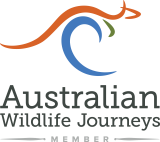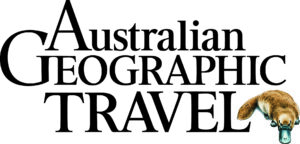Scott Roberts (centre) training wildlife guides Alison & Mark: Ubirr, Kakadu NP Vici Hasenau
Estimated reading time: 8 minutes
Scott Roberts loves training wildlife guides. As a senior wildlife guide at Echidna Walkabout Nature Tours — and an inveterate wildlife traveller — Scott knows that guiding a successful wildlife tour hinges on courage, compassion, camaraderie and lots more…..
What makes a great Wildlife Guide?
Just for fun, as I began to write this story, I thought I’d ask Google’s AI machine, Gemini, this question: “Which Australian tour company ranks highest for the quality of its wildlife guides?” and, in a split second, this popped up on my computer screen:
Echidna Walkabout Nature Tours:
- Deep Expertise and Passion: Their entire ethos is built around “conservation travel” and providing authentic wildlife encounters. This naturally attracts guides with a profound knowledge of Australian ecology, animal behavior, and a genuine passion for conservation.
- Focus on Wild Encounters: They specialize in finding animals in their natural habitats, which requires highly skilled guides who can “read” the environment, track animals, and interpret their behavior. Their reviews often highlight the guides’ ability to spot elusive species and provide in-depth information.
- Training and Experience: Their website mentions their guides being trained and experienced in observing wildlife, and even Roger, a key figure, spends much of his time imparting his wealth of knowledge to guides.
While it was flattering that Gemini mentioned me (how does it do that??) it should also have mentioned a few other people on my team at Echidna Walkabout but especially our chief guide trainer, Scott Roberts. This story is about him and the vitally important role he plays in finding and training wildlife guides for our business.
When Scott interviews potential wildlife guides it’s not surprising that he’s looking for people who have a comprehensive knowledge of flora and fauna. Candidates must also demonstrate a commitment to protecting and conserving wildlife and wild places. But these qualifications are just the starting point.
“Courage and compassion are essential qualities for a good wildlife guide,” Scott explains, “But when you combine those two then mix them with camaraderie, you have the true mark of a great wildlife guide.”
Why Wildlife Guide’s need courage
As a first rate wildlife guide you need buckets loads of courage for, on most days, you will head out into the unknown with guests who expect you to “provide the goods”! You know where you’re going and what you aim to achieve for your guests, but you don’t know what’s going to happen.
Nothing is guaranteed – that’s the thrill of wildlife in the wild.
Will the platypus be where it usually is? Will it pop up then immediately disappear? Will the crocodiles — mentioned glibly in the itinerary — be where they usually are or will they be elsewhere because the fish they hunt have gone?
What happens when you traipse up a steep hill on a steaming hot day to look down on an eagle’s nest only to find the eaglets, that were there yesterday, have gone? Or when the whale shark dives out of sight and doesn’t come up again?
How will you deal with guests who don’t think they’ve got what they paid for…..because it rains? Or it hasn’t rained for months? Or roadworks close access to your favourite waterhole where Pink Cockatoos come to drink most evenings?
Most dauntingly, will you, as a wildlife guide — working in the wild — meet guests’ expectations that may be completely different to what you know to be reality? And how do you help them come down when things don’t go as planned?
When you learn how to cope with the pressures wildlife and your guests place on you you’re well on the way to being a great wildlife guide. It takes courage to deal with this and a positive belief that the uncertainty of nature is what should delight us rather than upset us.
Compassion: the Wildlife Guide’s Secret
That’s where compassion for people and wildlife comes in.
Our guides help guests understand that no-one can put the ‘wild’ in a box and let it out on call. Wildlife comes out when it wants to, not when we want it to. You explain gently that to understand wildlife we need to embrace uncertainty and work with whatever the ‘wild’ hands out. That’s the joy of seeing wildlife in the wild and what makes nature so captivating.
We need to have compassion for the wildlife too; there are times when getting too close to a wild animal or interrupting its feeding or drinking will make its survival more difficult, maybe impossible if the disturbance happens regularly.
For example our citizen science research has shown that getting too close to koalas intimidates them. If this happens frequently koalas begin to suffer from mental and physical distress which can reduce the ability of their immune systems to counter deadly diseases like chlamydia. (Read our Sustainable Koala Watching Code)
So, going back to the eaglets, if they’ve vacated the nest, you try finding them nearby. While you’re doing that you look for other wildlife and enjoy that too! And if you never find the eaglets, rejoice at their success.
“When you successfully combine courage and compassion you’re well on the way to becoming a wildlife guide,” Scott says. “But there’s one extra ingredient that helps more than anything else: camaraderie.”
Camaraderie
“I give our guides support in the field by providing them with tools that allow them to share their experiences in real time or get others’ opinions when needed,” Scott explains, “We use modern phone technology extensively especially messaging apps like WhatsApp. We set up special chat groups one of which is devoted primarily to supporting guides while they’re on tour.
“My guides can share a photo of a bird or a lizard, whatever, and ask other guides what they think it might be: the answer may come through from another guide in a matter of minutes. And if that doesn’t work they can always try iNaturalist on their phone and see if that comes up with answer.”
Loneliness is also a real problem for guides leading extended tours. That may sound odd with guests around all the time, but without the support of friends and family — especially during stressful tours when, say, the weather is against you — it’s great to know that there’s the camaraderie of other like-minded guides just a quick message away.



📷all photos by Vici Hasenau
Echidna Walkabout’s Immersive Training
To help new guides understand all this, Scott teaches our wildlife guides using immersive training techniques that take in every aspect of a wildlife tour.
His training always happens in the bush, on location, and is planned to ensure that his trainees have all the tools they need to guide exceptional tours. But the planning starts well before the training…..
All Echidna Walkabout Wildlife Guides are trained to provide meaningful information about our conservation travel and citizen science program. They also learn about our climate action program including how they can help reduce greenhouse gas emissions and plastic waste. (for more details read: Conservation Travel: Help Nature While You Enjoy)
Training also includes techniques for providing in depth tour briefings detailing how we record the flora and fauna that we find on our tour and how that contributes to citizen science.
When Echidna Walkabout’s Wildlife Guides start a tour they have an extraordinary amount of support that has been prepared before the tour and is available to them during the tour using our online running sheets.
Guests are provided with a tour booklet set up specifically for their tour that includes comprehensive information about the region and a detailed wildlife checklist.
Our wildlife guides update the checklist with their guests on most days. They also keep an online checklist also updated daily. This list is distributed to all the people on the tour, generally within a week or two after the tour.
Training covers off on all of the above and we find that our guides are surprised not only by the depth of information they receive but also the support they get before, during and after a tour.

More information
Read about our specialist bird guides: Love finding birds with a top bird guide? Meet Martin and Australian Geographic
Guide Diaries: stories on or about Echidna Walkabout’s Wildlife guides
Help unleash the power of Conservation Travel
Step into the future of travel. Join one of our Conservation Travel tours. An increasing number of these tours include an important Citizen Science project.
Echidna Walkabout is a Founding Member of Australian Wildlife Journeys.
We also create, guide and operate tours for Australian Geographic Travel





GIPHY App Key not set. Please check settings